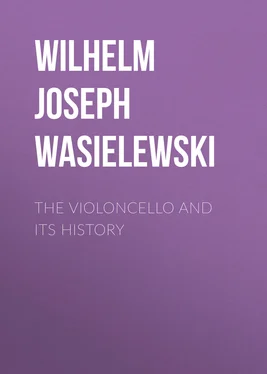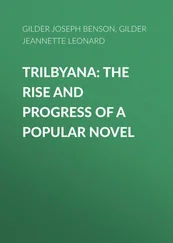Wilhelm Joseph von Wasielewski - The Violoncello and Its History
Здесь есть возможность читать онлайн «Wilhelm Joseph von Wasielewski - The Violoncello and Its History» — ознакомительный отрывок электронной книги совершенно бесплатно, а после прочтения отрывка купить полную версию. В некоторых случаях можно слушать аудио, скачать через торрент в формате fb2 и присутствует краткое содержание. Жанр: foreign_antique, foreign_home, music_dancing, на английском языке. Описание произведения, (предисловие) а так же отзывы посетителей доступны на портале библиотеки ЛибКат.
- Название:The Violoncello and Its History
- Автор:
- Жанр:
- Год:неизвестен
- ISBN:нет данных
- Рейтинг книги:3 / 5. Голосов: 1
-
Избранное:Добавить в избранное
- Отзывы:
-
Ваша оценка:
- 60
- 1
- 2
- 3
- 4
- 5
The Violoncello and Its History: краткое содержание, описание и аннотация
Предлагаем к чтению аннотацию, описание, краткое содержание или предисловие (зависит от того, что написал сам автор книги «The Violoncello and Its History»). Если вы не нашли необходимую информацию о книге — напишите в комментариях, мы постараемся отыскать её.
The Violoncello and Its History — читать онлайн ознакомительный отрывок
Ниже представлен текст книги, разбитый по страницам. Система сохранения места последней прочитанной страницы, позволяет с удобством читать онлайн бесплатно книгу «The Violoncello and Its History», без необходимости каждый раз заново искать на чём Вы остановились. Поставьте закладку, и сможете в любой момент перейти на страницу, на которой закончили чтение.
Интервал:
Закладка:
Fétis mentions twenty operas by Bononcini, but he doubtless wrote more. Even in his eightieth year he was occupied for the theatre in Venice. Besides, he wrote an Oratorio, “Joshua,” several orchestral pieces, masses, chamber duets, “Trattenimenti da Camera,” &c., some of which were composed before his entrance into the Vienna Hofkapelle. He also wrote “Sinfonie” for violin and violoncello as well as cello solos. Of the latter there appeared at J. Simpson’s (London) a sonata for two violoncellos in a collection of sonatas by Pasqualini, San Martino, Caporale, Spourni, and Porta. As Caporale was born in 1750 and Porta in 1758, the publication of this collection must have taken place late in the second half of the eighteenth century. The Bononcini sonata contained in it does not give a very favourable impression of this composer’s talent. The development is dry and in places very formal, even here and there somewhat incorrect. To the two figured parts are given accompanying basses, partly simple and partly contrapuntal. The interest which attaches to this composition, consisting of an Allegro , with introductory Andante , a movement marked “ Grazioso ,” and a “ Minuet ,” after which the “ Grazioso ” is to be repeated, rests chiefly on the light which it throws upon the technical condition of cello playing at the beginning of the eighteenth century (for doubtless the composition belongs to that period). In reference to this is to be remarked: the principal part is confined chiefly to the middle tones; the lower ones are only occasionally touched, and the compass of the higher notes reaches to the one-lined A; the thumb position does not come into use. Figure is little developed, and only modest attempts are made at playing double stoppings and chords; the notation is in tenor and bass clefs.
It is reported that during Bononcini’s residence in Paris, between 1735-1748, he composed a Motet with cello obbligato accompaniment, for the royal band there, which last he himself played at the performance of his work in the presence of the king.
Alessandro Scarlatti, 62 62 Born in 1649, at Trapani, in Sicily; died on October 24, 1725, at Naples. In Grove’s Dictionary, 1659 is given as the date of his birth—other authorities as above.—( Tr. )
the founder of the Neapolitan opera school, had given an example of this use of the violoncello about twenty-five years before in one of his cantatas. Geminiani, Corelli’s pupil, related that this cello part was performed during Scarlatti’s presence in Rome, and with his assistance on the clavier, by the famous violoncellist, Franciscello (Francischello); his playing was so beautiful that Scarlatti described it as heavenly.
This event must have occurred in the year 1713, when Scarlatti was in Rome the last time. Consequently, Franciscello’s birth must be placed with all probability in the year 1692. He would have been twenty-one years of age when he played with the Neapolitan master.
Gerber says that Franciscello went from Rome to Naples in 1725. That he was actually there in the year mentioned is affirmed by Quantz, who himself heard him play. Through Franciscello’s extraordinary performances the violoncello was soon so generally accepted in Italy, that the gamba had, in 1730, almost entirely disappeared from the Italian orchestras.
In the year 1730, Franciscello was summoned to Vienna as Imperial chamber musician, a proof that his name had already penetrated beyond his country. Franz Benda, afterwards celebrated as a violinist, and founder of the Berlin violin school, heard him in the Austrian capital. Franciscello’s manner of playing so impressed him that he took him from that time as his model.
Franciscello remained, it appears, ten years in Vienna. If a notice in the “Musical Almanack for Germany, of the year 1782,” is to be credited, he had already been a member of the Imperial Court and Chamber Music Society in 1766, which is by no means beyond the bounds of possibility, though not very probable. We hold then to the assumption that he was born in 1692 so that, in 1766, he would be already seventy-four years old. It is not known where Franciscello closed his life. Tradition only says that at an advanced age he resided in Genoa, to which the supposition was attached that that city had been his birthplace. It is stated that the elder Duport, the cello virtuoso, who was born in 1741, went from Paris to visit him there.
During his long period of work at Vienna, Franciscello doubtless instructed pupils in cello playing; who they were is however, as little known as the question if or what he composed for his instrument. On both points we are no better off than concerning his somewhat older compatriot
Cervetto, called Jacopo Bassevi, who was born in 1682. Until his forty-sixth year he remained in his fatherland. Then, like so many other Italian musicians of this time, he was seized with a desire to travel, and betook himself to London. There he trafficked at first in instruments which he had brought with him from Italy; this, however, was so little remunerative that he very soon gave it up, and joined the orchestra of Drury Lane Theatre. According to Burney’s judgment, Cervetto was, for his time, a very clever violoncellist, who knew how to manipulate the fingerboard with much dexterity; but his tone must have been rough and harsh. Of his eccentricity the following anecdote is an illustration: Once when the famous Garrick was representing a drunkard and sank down senseless upon a seat, Cervetto broke upon the sudden stillness with an unseemly loud and long-drawn yawn. Garrick immediately got up, severely censuring such behaviour, upon which Cervetto pacifying him answered: “I beg your pardon, I always yawn when I am very pleased.” A few years later Cervetto became Director of Drury Lane Theatre, and thus he laid the foundation of his fortune.
Cervetto must have had a very strong constitution, for he lived to the unusual age of 101 years. His death took place on January 14, 1783. He left a fortune of £20,000 sterling, which he bequeathed to his son James, who was also a cellist; but soon after inheriting from his father he retired into private life. He, also, reached a respectable age, for as he came into the world (in London) in 1747, and died February 5, 1837, he was ninety years old. In 1783 he was performing at the Court concerts of the Queen, as well as taking part in the musical réunions in the house of Lord Abington as one of the best reputed cellists in London. Of cello compositions he published: 1. Twelve “Solos for a Violoncello, with a Thorough Bass for the Harpsichord”; this work, dedicated to the Elector Palatine of Bavaria and Jülich-Eleve-Berg, appeared at the author’s own expense, without date. 2. “Six Solos for a Violoncello, with a Thorough Bass for the Harpsichord, Opera Terza.” London. 3. “Twelve Sonatinas for a Violoncello and a Bass, Op. 4 ta.” London. Fétis adds, besides, “Six solos pour la flûte” and “Six trios pour deux violons, et violoncelle,” which must have been in existence not long before the end of the last century. We shall have occasion to refer again farther on to Cervetto’s violoncello compositions.
Taking up again the chronological thread, after Cervetto the elder, the cellist Batistin, whose real name was Joh. Baptist Struck, must be mentioned. He was of German origin and was born in Florence in the second half of the seventeenth century, from thence he went to Paris at the beginning of the eighteenth century. He there entered the band of the Duke of Orleans and the opera orchestra, in which he, conjointly with the brothers Abbé (properly Philippe Pierre and Pierre de Saint-Sévin), played the cello parts. He must have performed well, since Louis XIV., in order to retain him in the French capital, gave him a liberal allowance and, in addition, a sum of 500 francs for certain theatrical compositions to be supplied by him. Besides this he wrote a long list of ballets and operas specially for Court festivities. There appeared in print, by him, during the years 1706 and 1714, in Paris, four books of “Cantatas” and a collection of airs. He does not appear to have composed for the violoncello. He died on December 9, 1755, at the scene of his work. Among the masters of the Neapolitan school, Leonardo Leo, at that time the famous opera composer, distinguished himself as a violoncellist, who was born, 1694, at S. Vito degli Schiavi, in the province of Lecco, and died at Naples in 1746. He also composed six cello concertos with quartet accompaniments, which belong to the years 1737 and 1738. The MSS. of these are in the Library of the Royal Conservatoire at Naples. It is supposed that these are the oldest of existing cello concertos.
Читать дальшеИнтервал:
Закладка:
Похожие книги на «The Violoncello and Its History»
Представляем Вашему вниманию похожие книги на «The Violoncello and Its History» списком для выбора. Мы отобрали схожую по названию и смыслу литературу в надежде предоставить читателям больше вариантов отыскать новые, интересные, ещё непрочитанные произведения.
Обсуждение, отзывы о книге «The Violoncello and Its History» и просто собственные мнения читателей. Оставьте ваши комментарии, напишите, что Вы думаете о произведении, его смысле или главных героях. Укажите что конкретно понравилось, а что нет, и почему Вы так считаете.












![Edward Ellis - Adrift on the Pacific - A Boys [sic] Story of the Sea and its Perils](/books/753342/edward-ellis-adrift-on-the-pacific-a-boys-sic-s-thumb.webp)